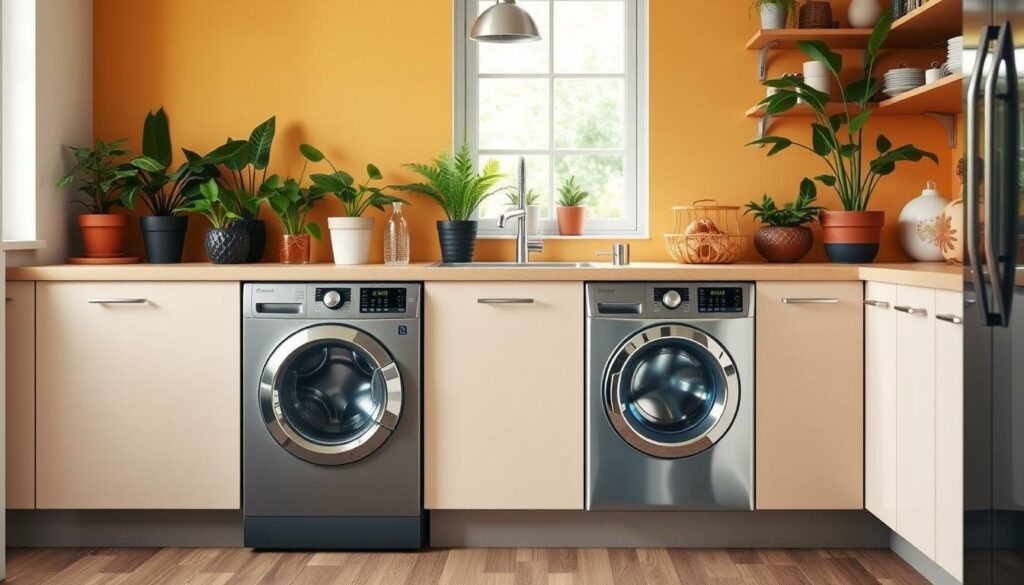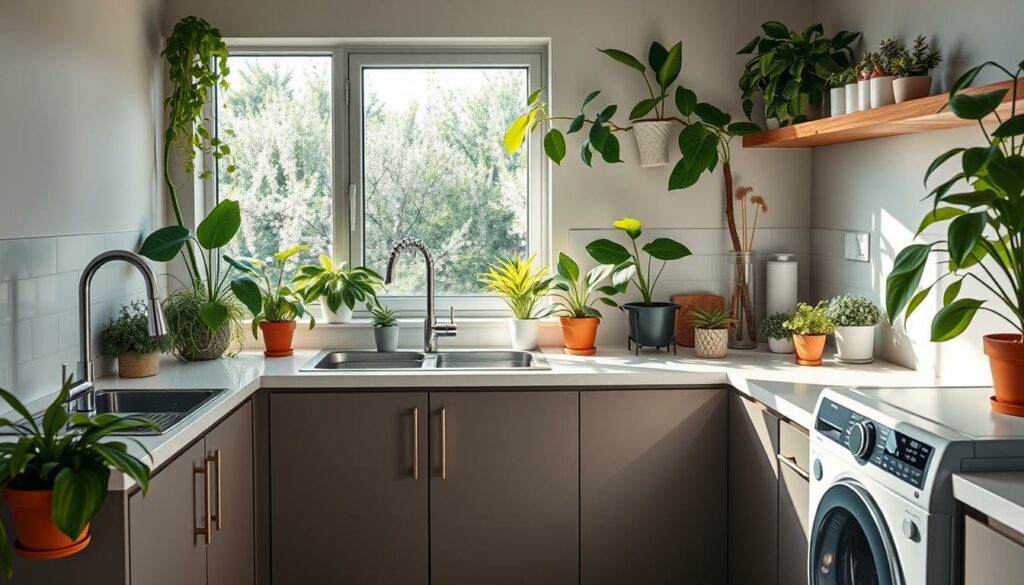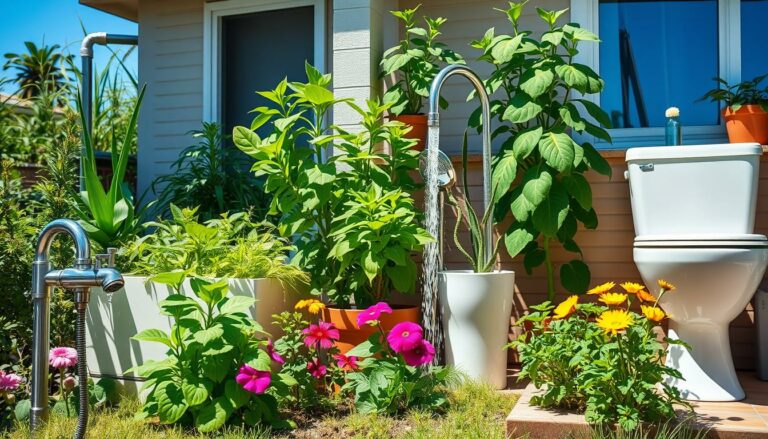Did you know the average American household uses about 300 gallons of water daily? This shows how important it is to save water at home. With a few easy steps, you can use less water and help the planet.
Key Takeaways
- The average shower uses 2-5 gallons of water per minute, but water-saving showerheads can cut this to 3 gallons per minute.
- Leaks can waste water 24/7, so regularly checking for and fixing leaks is crucial.
- Watering your lawn and garden only when necessary can prevent unnecessary water usage.
- Replacing old appliances with water-efficient models can significantly reduce your household’s water consumption.
- Rainwater harvesting and greywater reuse systems can help you recycle water for non-potable uses.
Understanding the Importance of Water Conservation
Water is vital for life, farming, and the environment. Yet, over 40% of the world’s people face water shortages. This shows we must act fast to save water for now and the future.
Why Water Conservation Matters
Water conservation is key for many reasons. Only about 3% of the world’s water is fresh and available for us. This makes saving water crucial. Also, water shortages can lead to food shortages because farming uses a lot of water. Lastly, water scarcity can cause people to move, leading to social and political problems.
Water: A Finite Resource
Water is limited, and by 2025, half the world might not have enough. Places like India and Asia already struggle with water. Climate change, growing populations, and bad farming practices make things worse. Protecting watersheds and freshwater ecosystems is essential to prevent irreversible environmental impacts.
Using less water helps a lot. Shorter showers, fixing leaks, and efficient appliances can save a lot. By acting now, we can protect water for future generations.
“Water scarcity is one of the greatest challenges of our time, and it’s only going to get worse. We all have a responsibility to use water more efficiently and protect this precious resource for the future.”
Detecting and Fixing Toilet Leaks
Toilet leaks can waste a lot of water, up to 200 gallons a day. Learning to spot and fix these leaks can save water and money. The first step is to find where the leak is coming from.
The Food Coloring Test
Try the food coloring test to find a leak. Put a few drops of food coloring in the tank. Wait 30 minutes without flushing. If the bowl turns colored, you have a leak.
This means the flapper or fill valve might need a new one. Replacing them can fix the problem.
Reducing Toilet Tank Water Level
Lowering the tank water level can also save water. If the water is too high, it keeps flowing into the overflow tube. This wastes water.
Find the adjustment screw or float cup. Lower the water level until it’s just below the overflow tube. This small change can help a lot with saving water.
By catching and fixing toilet leaks early, you help with toilet leak detection and water conservation. These water-saving tips can cut down on waste and lower your bills.
“Fixing toilet leaks can lead to significant water and cost savings at home.”
Sustainable Living: Shower and Bath Habits
Your shower and bath habits are key to saving water at home. Showers and baths use up to 20% and 5% of your water, respectively. By changing your habits, you can save water without giving up on cleanliness and comfort.
Taking Shorter Showers
Shortening your shower time is a simple way to save water. The average shower lasts 8 minutes, using 65-75 liters of water. Try to shower for 5 minutes or less to cut down on water use.
Water-Saving Showerheads
Switching to a water-efficient showerhead is also a good idea. Old showerheads use about 9 liters per minute. But, new ones like the Methven Aio Aurajet or the Hudson Reed Slide Rail Kit use up to 60% less water. They still give you a great shower while saving water.
Adding these habits to your daily routine can really help the environment. Every bit of water you save helps make our future greener.
Brushing and Shaving Without Wasting Water
Small changes in your daily routine can make a big difference in water-conscious personal hygiene. Being mindful of sink water usage reduction while brushing teeth and shaving helps save water. This way, you can care for yourself without harming the environment.
When brushing your teeth, wet your toothbrush first and use a small glass of water for rinsing. This simple step can save a lot of water over time. For shaving, fill your sink with a little water to rinse your razor instead of letting the water run.
For a greener shaving routine, think about using a safety razor. Safety razors use replaceable blades, cutting down on waste from disposable razors. Use it with a shaving brush and natural soap or cream for a luxurious, eco-friendly shave.
| Sustainable Shaving Practices | Benefits |
|---|---|
| Using a safety razor | Reduces waste from disposable razors, provides a closer shave, and requires less maintenance |
| Incorporating a shaving brush | Lifts hair and exfoliates the skin for a smoother shave |
| Choosing natural shaving products | Avoids synthetic chemicals and reduces environmental impact |
| Filling a sink with water for rinsing | Conserves water by avoiding running the tap continuously |
By tweaking your personal hygiene habits, you can help save water and reduce your environmental impact. You don’t have to give up your daily grooming routines to do it.
“Conserving water is everyone’s responsibility. Small changes in our daily habits can have a significant impact on our environment.”
Preventing Faucet and Pipe Leaks
Keeping your home’s plumbing system in good shape is key to saving water and avoiding damage. Leaks from faucets, pipes, or fixtures can waste a lot of water each year. This can raise your water bills and harm the environment. By finding and fixing leaks early, you can use less water and help the planet.
Regular Leak Checks
Checking for leaks regularly is a smart first step. Look at all faucets, showerheads, and pipes for drips or moisture. Focus on the kitchen and bathrooms, as leaks often happen there. Also, watch your water meter for sudden increases, which might mean a hidden leak.
Leak detection is important for saving water.
Replacing Washers and Aerators
Worn-out washers and aerators often cause faucet leaks. These parts can get damaged or fall out, wasting water. Replacing them is cheap and helps save water. Also, get water-saving faucets to cut down on your water use even more.
| Issue | Estimated Water Waste | Potential Savings |
|---|---|---|
| Dripping faucet (1 drip per second) | 3,000 gallons per year | $35 annually |
| Showerhead leak (10 drips per minute) | 500 gallons per year | $6 annually |
| Toilet leak (3 gallons per minute) | 288,000 gallons per year | $3,456 annually |
By being quick to spot and fix leaks, you can save a lot of water. This makes your home more eco-friendly.
Efficient Dishwashing and Laundry
Dishwashing and laundry use a lot of water, up to 17% and 19% of household use. But, you can use less water without losing cleanliness. Just follow a few easy steps.
Full Loads Only
Always fill your dishwasher and washing machine to the brim. Running them with less water wastes it and uses more energy. New, ENERGY STAR appliances use less water, like 3 gallons per cycle. Older ones can use up to 15 gallons.
Scraping Instead of Rinsing
Washing dishes before the dishwasher wastes a lot of water, up to 600 gallons a year. Just scrape off food with a spatula or brush. This saves a lot of water without dirtying your dishes.
By using these tips, you help save water and cut down on bills. Small changes can make a big difference in saving water and living sustainably.

“Choosing eco-settings or lower temperatures for the dishwasher can improve its environmental impact.”
Outdoor Water Conservation
As homeowners, we can greatly reduce water usage by focusing on our outdoor spaces. Up to 30% of household water goes to lawn watering and car washing. By using sustainable landscaping and eco-friendly practices, we can save water and keep our homes looking great.
Lawn Watering Tips
The lawn is a big water user. Here are some tips to keep it green without wasting water:
- Water early in the morning or late in the evening to reduce evaporation.
- Adjust your watering schedule based on the weather and season – less water is needed during cooler, overcast days.
- Install a smart irrigation system that adapts watering based on soil moisture levels and weather conditions.
Drought-Resistant Landscaping
Using drought-resistant plants and sustainable landscaping designs can also help. These plants need less water and can make your outdoor space beautiful and easy to care for.
Eco-Friendly Car Washing
For washing your car, skip the hose and go for a eco-friendly car washing method. Use a bucket and sponge, or visit a car wash that recycles water. These actions can save a lot of water each year.
By following these outdoor water conservation tips, you can help save water and keep your home’s exterior looking good. Small changes can make a big difference, so start today!
Installing Water-Efficient Appliances and Fixtures
Switching to water-saving appliances and low-flow fixtures is a smart move for your home. By installing these upgrades, you can cut down on water use and lower your bills.
Begin by swapping out old toilets for new, water-efficient ones. These can save thousands of gallons a year. Also, consider water-saving showerheads, which can cut water use by up to 50% compared to regular ones. High-efficiency washing machines and Energy Star-certified dishwashers also help save water and energy.
- Choose WaterSense-certified fixtures for top efficiency without losing performance.
- Opt for Energy Star-rated appliances for better energy savings and environmental benefits.
- Install a rainwater harvesting system to lessen your reliance on city water.
These upgrades might cost more upfront, but they save money and the planet in the long run. Making your home more water-efficient shows your dedication to living sustainably.
“Every drop of water saved and every watt of energy conserved matters in promoting sustainability.”

Maximize Your Water and Energy Savings
When buying new items, look for the WaterSense and Energy Star labels. These labels mean the products are highly efficient, saving water and energy.
| Product | Water Savings | Energy Savings |
|---|---|---|
| High-Efficiency Toilet | Up to 13,000 gallons/year | N/A |
| Water-Saving Showerhead | Up to 50% | N/A |
| Energy Star Washing Machine | Up to 20 gallons/load | 25-50% |
| Energy Star Dishwasher | Up to 3 gallons/load | 12-50% |
| Tankless Water Heater | N/A | Up to 34% |
Rainwater Harvesting and Greywater Reuse
In a world facing water scarcity, new solutions like rainwater harvesting and greywater reuse are key. These methods help cut down household water use and ease pressure on traditional water supplies.
Rainwater harvesting collects and stores rainwater for later use. It’s great for irrigation, toilet flushing, laundry, and cleaning. By using this natural resource, you can save a lot of water each year. This reduces your need for municipal water and lowers costs.
Greywater reuse, on the other hand, recycles water from sinks, showers, and washing machines. This water is treated and used for outdoor irrigation or other non-drinking needs. Greywater systems cut down freshwater use for household tasks, saving this valuable resource.
| Metric | Value |
|---|---|
| Freshwater availability on Earth | Only about 2% of water on Earth is freshwater, most of which is underground or frozen in glaciers and ice caps. |
| Daily water use in American homes | Tens of billions of gallons of water are used in American homes daily, contributing to the strain on water sources. |
| Potential rainwater harvesting in San Marco, Texas | In an area like San Marco, Texas, with 890mm (35 inches) of rainfall a year, and a combined 185m2 (2000ft2) catchment area, a person can harvest 164,650L (43,496gal) of rainwater each year. |
| Potential greywater reuse per person | Approximately 25 gallons of greywater per person, per day, can be collected from the bathroom and laundry, totaling up to 9000 gallons per year. |
Using rainwater collection and greywater systems, homeowners can greatly reduce their water use. This helps with sustainable water management. It also saves water, lessens demand on municipal systems, and supports the environment.
“Rainwater harvesting and wastewater reuse protect wetlands, reduce reliance on traditional water sources, and lessen demand on municipal water systems.”
Conclusion
In this guide, we’ve covered many ways to cut down on water use at home. We’ve talked about fixing leaks and using water wisely when washing dishes and doing laundry. These tips help you make a big difference in saving water.
Using less water is good for the planet and saves you money in the long run. It helps keep our water resources safe and supports green communities.
Water conservation is a team effort. By following these tips, you can set a good example. You can encourage your family and friends to join you in saving water. Together, we can make our future greener and more water-friendly.
FAQ
What is the importance of water conservation?
How can I detect and fix toilet leaks?
How can I conserve water in the shower and bath?
How can I minimize water usage while brushing teeth and shaving?
How can I detect and fix leaks in my home?
How can I optimize water usage for dishwashing and laundry?
How can I conserve water in my outdoor areas?
What are the benefits of installing water-efficient appliances and fixtures?
What are rainwater harvesting and greywater reuse, and how can they contribute to water conservation?
Source Links
1 . 25 ways to save water
2 . 10 Ways to Conserve Water for a Sustainable Living
3 . Magnus Home Products – Inspired Living: Ideas for Your Home, Kitchen and Bathroom
- Growing Bonsai: Tips for Miniature Tree Enthusiasts
- Buying Bonsai: Tips for Selecting Your Perfect Tree
- Bonsai Potting: Essential Tips for Tree Care Success
- Bonsai Maintenance: Essential Care for Tiny Trees
- Mastering the Art of Shaping Bonsai: A Beginner’s Guide


